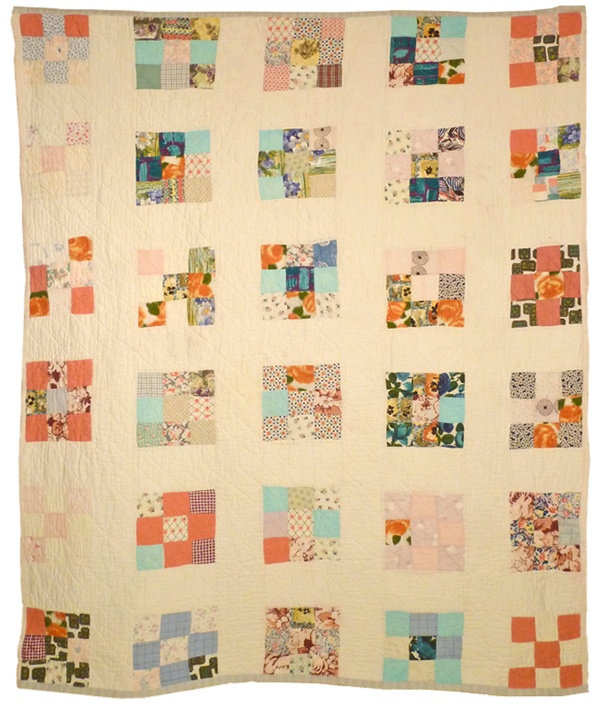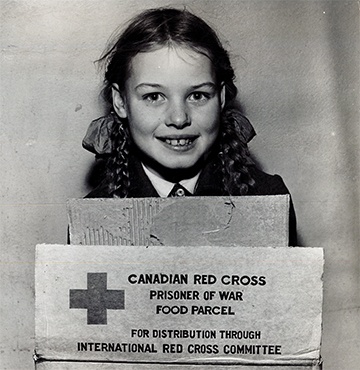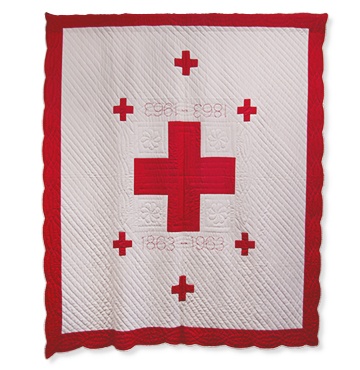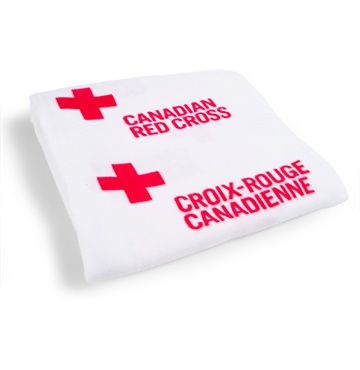Canadian Red Cross Quilt
After 1945, the Canadian Red Cross gradually expanded the scope of its peacetime work to embrace on-the-ground humanitarian aid in many parts of the world. Women volunteers found a new outlet for their needlework by producing items for sale or for use as relief supplies. Canadian Red Cross quilts, like this one received by a family in the Netherlands, gained a reputation for excellence, a quality that transferred into postwar Red Cross needlework.
In 1944, Allied and Axis forces battled for control of the Netherlands, and the Dutch family who received this quilt took refuge in a cellar for 10 days and nights during a particularly intense artillery barrage. Made in the “nine-patch” style, the quilt was one of thousands shipped overseas during the war. It was saved by the family and passed on to son Willem’s wife Els, who later returned it to Moose Jaw, Saskatchewan, where it was created.
The “Women’s War Work” sewing and knitting program of the First (1914-18) and Second (1939-45) World Wars was renamed simply “Women’s Work” after 1945. In its new postwar format it initially involved producing clothing and linens for relief and rehabilitation work in the former war zones. As Europe got back on its feet, the Red Cross turned its eyes to other parts of the world that might benefit from humanitarian aid.
This shift away from Europe was mirrored in the Women’s Work program, which began producing items more suitable to the warmer climates of Africa, South Asia, Central and South America. This meant (for example) fewer quilts and more lightweight cotton garments.
The program was later revamped, first in 1976 as “Assistance International and Domestic (AID)” when it hoped to draw in some men already working in the Veterans’ Arts and Crafts program, and again in 1986 as “Creations.” In the mid-1970s the Red Cross shifted toward using donated money to purchase items made locally in affected areas, instead of sending Canadian supplies. AID/Creations volunteers began producing items for sale in Canada, with the proceeds going to fund Red Cross international work.
Canadians’ voluntary needlework and handicrafts for the Red Cross served a consistently important purpose throughout the twentieth century. Whether they were creating practical, beautiful, or whimsical items, these volunteers demonstrated a “hands-on” humanitarianism by turning their manual skills to the benefit of people they would never meet face-to-face.
After 1945, the Canadian Red Cross gradually expanded the scope of its peacetime work to embrace on-the-ground humanitarian aid in many parts of the world. Women volunteers found a new outlet for their needlework by producing items for sale or for use as relief supplies. Canadian Red Cross quilts, like this one received by a family in the Netherlands, gained a reputation for excellence, a quality that transferred into postwar Red Cross needlework.
In 1944, Allied and Axis forces battled for control of the Netherlands, and the Dutch family who received this quilt took refuge in a cellar for 10 days and nights during a particularly intense artillery barrage. Made in the “nine-patch” style, the quilt was one of thousands shipped overseas during the war. It was saved by the family and passed on to son Willem’s wife Els, who later returned it to Moose Jaw, Saskatchewan, where it was created.
The “Women’s War Work” sewing and knitting program of the First (1914-18) and Second (1939-45) World Wars was renamed simply “Women’s Work” after 1945. In its new postwar format it initially involved producing clothing and linens for relief and rehabilitation work in the former war zones. As Europe got back on its feet, the Red Cross turned its eyes to other parts of the world that might benefit from humanitarian aid.
This shift away from Europe was mirrored in the Women’s Work program, which began producing items more suitable to the warmer climates of Africa, South Asia, Central and South America. This meant (for example) fewer quilts and more lightweight cotton garments.
The program was later revamped, first in 1976 as “Assistance International and Domestic (AID)” when it hoped to draw in some men already working in the Veterans’ Arts and Crafts program, and again in 1986 as “Creations.” In the mid-1970s the Red Cross shifted toward using donated money to purchase items made locally in affected areas, instead of sending Canadian supplies. AID/Creations volunteers began producing items for sale in Canada, with the proceeds going to fund Red Cross international work.
Canadians’ voluntary needlework and handicrafts for the Red Cross served a consistently important purpose throughout the twentieth century. Whether they were creating practical, beautiful, or whimsical items, these volunteers demonstrated a “hands-on” humanitarianism by turning their manual skills to the benefit of people they would never meet face-to-face.




